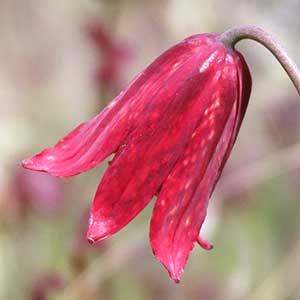Fritillaria biflora
Fritillaria gentneri
chocolate-lily, mission bells
Gentner's fritillary
large 2–8; small 0–4.
large several; small numerous.
1–4.5 dm.
5–7 dm.
3–7, alternate, often ± crowded just above ground level, 5–19 cm;
blade linear or oblong to narrowly ovate.
in 1–3 whorls of 3–5 leaves per node proximally, alternate distally, 7–15 cm;
blade broadly linear to lanceolate.
nodding, odorless or sometimes with unpleasant odor;
tepals dark brown to greenish purple or yellowish green, narrowly ovoid, 1.8–4 cm, apex not recurved;
nectaries prominent, purplish to greenish, narrowly linear, forming narrow band 2/3 to equaling tepal length;
style obviously branched for 1/2–2/3 its length, branches longer than 1.5 mm.
spreading to nodding;
perianth broadly campanulate;
tepals red to purple, clearly mottled with yellow, 3.5–4 cm, apex spreading, not recurved;
nectaries linear, 1/2 tepal length;
style obviously branched for 1/3–1/2 its length, branches widely spreading, longer than 1.5 mm.
angled.
winged.
Fritillaria biflora
Fritillaria gentneri
Varieties 2 (2 in the flora).
This species is sometimes confused with Fritillaria agrestis, which grows in heavier soil and has flowers with an unpleasant odor. Fritillaria roderickii is still recognized by some botanists, but it appears to be little more than a localized flower-color variant of F. biflora var. biflora, and is valued by horticulturists for this reason.
(Discussion copyrighted by Flora of North America; reprinted with permission.)
Of conservation concern.
Fritillaria gentneri is a restricted endemic closely allied with F. recurva and F. affinis, with which it can be confused. Some evidence suggests that it may represent a hybrid between those two species. More study is needed to determine whether it should remain recognized as a distinct species.
(Discussion copyrighted by Flora of North America; reprinted with permission.)
1. Leaf blade widely lanceolate to oblanceolate. | var. biflora |
1. Leaf blade linear to narrowly lanceolate. | var. ineziana |


